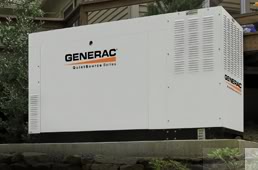Types of Whole-House Generators

A whole-house generator will keep electrical appliances running in your home even if your utility provider experiences a power outage. Emergency, standby or backup generators can be installed outside your home to provide power for everything from refrigerators, freezers and lights to life-saving medical equipment. Generators take over as soon as grid power is interrupted, and turn off once grid power is restored. To help you make the right choice, this guide provides information on the types of whole-house generators available.
Automatic or Manual Switch
There are two basic types of switches to initiate power to your whole-house generator:
An automatic transfer switch (ATS) will automatically turn your generator on in the event of an outage. The big advantage of having an ATS installed on your whole-house generator is that you do not have to be home to start it. If you travel often and live in an area that experiences frequent power failures, a generator with an ATS is recommended. Transfer switches are available in three sizes: 50 amps, 100 amps and 200 amps. Ask your electrician to help you choose the right size or check for the information on your home’s main breaker panel.
A manual switch requires the homeowner to be present in order to turn on the whole-house generator and provide power to the home’s appliances. Though less expensive, manual operation switches are less desirable.
How to Choose the Right Whole-House Generator
To decide which whole-house generator is right for you, considerwhich of the following items you will need to operate during a grid power outage, and the estimated wattage required to keep them running:
- Refrigerator - 500-700 watts
- Freezer - 600 watts
- Well pump - 1/3 horsepower, 750 watts; 1/2 horsepower, 1000 watts
- Sump pump - 1/3 horsepower, 800 watts; 1/2 horsepower, 1050 watts
- TV - LED/LCD, 50 watts; Plasma, 240 watts
- DVD player - 15 watts
- Computers - Desktop with monitor, 200-400; Laptop, 20-85 watts
- Printers - Inkjet, 15-75 watts; Laser, 500 watts
- Garage door opener - 445 watts
- Electric stove - 1000-1500 watts
- Microwave - 600-1000 watts
- Air Conditioner (7K-10K BTU) - 1000-1500 watts
- Fans - 50-120 watts
- Washing machine - 1000-2300 watts
- Clothes dryer - Electric, 5000 watts; Gas, 1800 watts
- Furnace fan - 300-875 watts
- Dishwasher - Cool dry, 700 watts; Hot dry, 1450 watts
Part of your decision will be based on whether you want to power all operations in your entire home or provide energy for scaled-back operations to a few necessary appliances, such as a typical 4-ton central air conditioner, plus a few other kitchen appliances and electronic equipment.
Air-Cooled vs. Liquid-Cooled
The general rule of whole-house generators is that the most powerful are also the most complicated. Air-cooled generators provide only up to about 20 kilowatts of electricity but are sufficient to power most single-family dwellings. For larger homes, bigger, more expensive liquid-cooled units are required. Common liquid-cooled units generate up to about 150 kilowatts of energy.
By carefully considering the appliances and equipment you intend to use if a power outage occurs, you will better equipped to purchase the appropriate whole-house generator. For more information and professional installation, contact a licensed electrician in your area.
Updated August 1, 2018.
Related Articles
Looking for a Pro? Call us (866) 441-6648

Electrical Average Costs
Electricians Experiences

Replacement Of A Light Fixture That Literally Fell Off The Ceiling

How My Attic Fan Installation Helped Me Sleep At Night



